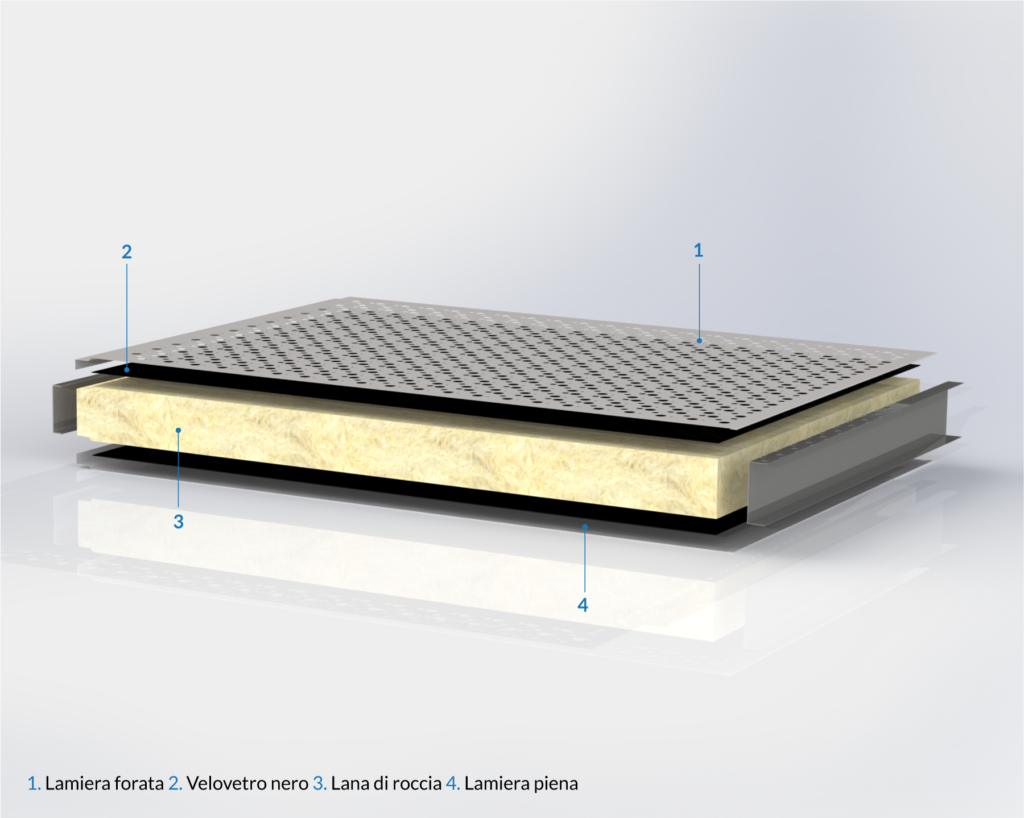Acoustic insulation: rock wool and perforated sheet

When we talk about insulation and environments, the first aspect we usually highlight is thermal insulation, or the back and forth heat exchange between internal and external environments.
However, we must not disregard the importance of protecting ourselves from noise to ensure good environmental comfort.
In fact, noises with certain intensity and spectral composition can produce an auditory deficit over time, which hampers people’s ability to perceive the acoustic frequencies of the spoken voice (500, 1000, 2000 Hz), and seriously damages the quality of life.
To clarify this aspect, we should take a step back and do a brief acoustics refresher.
How are sound waves propagated?
When a sound wave encounters an obstacle e.g. a wall, its energy is dispersed in several parts: one part is transmitted by the mass of the wall, another is transmitted beyond the wall, propagating in the neighbouring environment, and yet another one is reflected back to the environment from which it came.
According to the behaviour of sound waves, we can classify sound insulation materials based on their soundproofing and sound absorption capacity.
Sound insulation is the ability of a system to isolate an environment from external sounds and vice versa. This capacity varies with the sound frequency and physical and dimensional properties of the insulating medium, in particular its mass and thickness. Their nature, in fact, determines the isolated frequencies.
Conversely, sound absorption refers to the ability of a structure not to reflect energy towards a sound source. This capacity relies on the material’s ability to absorb more or less acoustic energy.
As a rule, porous materials are more absorbent than smooth and compact ones.
In essence, sound-absorbing materials are mainly used to improve the acoustic quality indoors, whilst sound-insulating materials are suitable for protecting against external noise.
To solve problems related to thermal and acoustic insulation, time and resources must be invested in research and experimentation.
Which materials are suitable for noise reduction and for soundproofing interventions?
Rock wool is certainly an excellent solution in terms of acoustic and thermal insulation. It is a natural material consisting of mineral fibres which, due to its porous nature, deliver excellent noise attenuation performance.
Panurania’s panels use rock wool as an insulating core for sound absorption.
Its characteristics make it an excellent ally of acoustic and thermal insulation; moreover, being a natural material, it is recyclable and biosoluble.
Rock wool also presents fire-retardant properties, which makes a difference in terms of safety: rock wool fibres, in fact, are intrinsically incombustible.
Breathable, resistant to humidity and anti-mould, rock wool hinders the proliferation of microorganisms and parasites.
The acoustic performance of insulating panels is strongly influenced by the sheet perforation features.
Perforated sheets: characteristics, uses and behaviour
Perforated sheets are produced by processing very thin metal sheets, on the surface of which holes of different shapes (round, square, oblong and hexagonal) are arranged in various configurations. They are broadly used as dividers and ornamental elements.
How does it work?
Sheet holes act as a set of so-called Helmholtz resonators. These resonators can dissipate acoustic energy as heat thanks to the viscous friction generated inside them by air oscillations. By their sheer presence, holes expand the sheet absorption spectrum relative to that of individual resonators. The great versatility of perforated sheets allows maximum absorption in the specific frequency band desired.
Insulating panels, a practical example of acoustic reclamation: Panurania’s Uran Sound Absorption Wall.
Acoustic reclamation refers to the set of actions necessary to comply with acoustic limits.
Panurania’s Uran Sound Absorption Wall is a concrete example of acoustic reclamation for pre-existing industrial environments .
Made with front and perforated steel sheet, the panel is usually installed in an existing wall, increasing the absorption capacity and thus also reducing the cost of a second sheet. Its absorption power depends on the thickness of the rock wool. The steel sheet used in the panel can have different thicknesses to enhance its performance. The large perforated surface guarantees an excellent absorption capacity.
Features and technical specifications are available at this link: https://panurania.com/it/2-prodotti/51-Uran_Sound_Absorption_Wall
Another Panurania solution for acoustic insulation in industrial environments is the Uran Sound Insulation Wall.
Unlike the Absorption Wall, equipped with a single perforated steel sheet, the Insulation Wall features two steel sheets: an internal perforated steel sheet for sound absorption, and an external, solid (non-perforated) steel sheet for noise reduction.
The high performance of this self-supporting sandwich panel is guaranteed by the large perforated surface and the sheet reinforcement.
Solid vs. perforated sheets: differences and behaviour
As we have seen previously, perforated sheets feature holes on the surface that act as a set of Helmholtz resonators. The greater the number of holes on the sheet, the wider the absorption spectrum.
Solid metal sheets, however, feature no holes, allowing sound waves that have already passed through the rock wool – and that have not been completely absorbed – to return and disperse in the insulating layer.
In practice, the mass of this particular sheet metal gives the panel a greater insulation and frequency filtering capacity.
Panurania’s Uran Sound Insulation Wall features both sheet metal types: solid and perforated.
Features and technical specifications are available at this link:
https://panurania.com/it/2-prodotti/52-Uran_Sound_Insulation_Wall